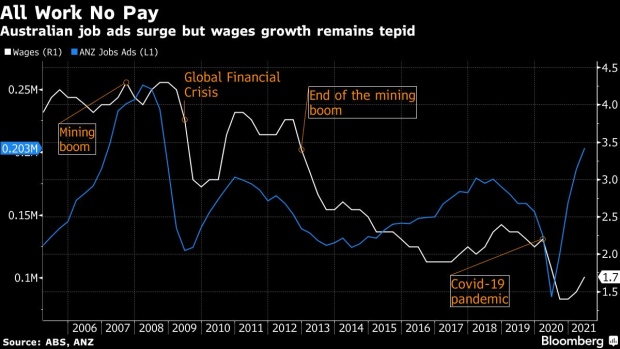Nov 15, 2021
RBA Says Distribution of Possible Inflation Outcomes Has Widened
, Bloomberg News

(Bloomberg) -- Australia’s inflation outlook differs from many other advanced economies, the Reserve Bank said, while acknowledging that quicker consumer-price gains last quarter had altered the picture.
“The risks to the inflation forecast had changed, with the distribution of possible outcomes shifting upwards,” the RBA said in minutes of its November meeting Tuesday. Key uncertainties included the duration of global supply chain disruptions and how wages respond to very low unemployment, it said.
The comment reinforces the tension between central banks and markets over the likely trajectory of inflation, with traders urging policy makers to begin tightening to head off faster price growth. Australia’s central bank, like counterparts around the world, is grappling with whether a recent acceleration in inflation is temporary or more enduring.
Governor Philip Lowe has kept interest rates at 0.1% and reiterated that they will not be lifted until inflation is “sustainably” within the RBA’s 2-3% target, a goal he sees as unlikely to be met before 2024.
To reach the CPI target, “the labor market will need to be tight enough to generate materially higher wages growth than at the time of the meeting,” the central bank said today. “The board will not raise the cash rate until these criteria are met, and is prepared to be patient.”
The RBA abandoned its three year-yield target two weeks ago after faster-than-forecast inflation sparked a bond sell-off that sent short-term yields surging.
Its dovish stance has been challenged by rate traders, emboldened by rapid Covid-19 immunization rates and an earlier-than-expected reopening of the nation’s A$2 trillion ($1.5 trillion) economy. Market pricing now imply at least three rate increases next year with a chance of a fourth hike.
Lowe is due to speak at 1:30 p.m. Sydney time on “Recent Trends in Inflation.”
The RBA reaffirmed its decision to continue with its A$4 billion a week bond program until mid February 2022, when it will be reviewed. This will be based on three considerations:
- the actions of other central banks
- how the domestic bond market is functioning; and
- the actual and expected progress towards the goals for inflation and unemployment
The RBA is trying to push unemployment down toward 4% to spark faster pay gains and revive inflation.
Earlier this month, it upgraded its economic forecasts, now expecting underlying inflation to hit the 2.5% mid-point of its target by end-2023.
©2021 Bloomberg L.P.